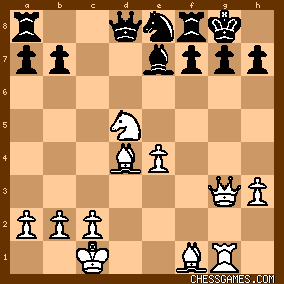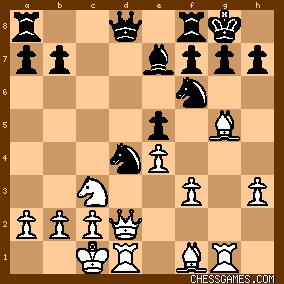|
< Earlier Kibitzing · PAGE 2 OF 2 ·
Later Kibitzing> |
Apr-05-05
 | | offramp: In my .cbh file of Kortschnoi's game this game ends after 25.Bxf6+. Black's only move to avoid mate is 25...Kd7, when 26.Qe6 is one of many moves that win. |
|
| May-12-05 | | Gowe: I think relarz is right, ¿Korchnoi missed mate in two?
<25.Rxg7+ and 26.Qf7++>
(I suppose that he mean 25., not 26.).
But probably <Offramp> and <InfinityCircuit> are right, is impossible that Korchnoi would miss that mate. |
|
May-12-05
 | | WannaBe: <Gowe> How do you get that upside down question mark? |
|
| May-12-05 | | radu stancu: <WannaBe> A Spanish keyboard perhaps?! :) |
|
May-12-05
 | | WannaBe: Darn, I was hoping it was some special escape characters that I can use... now I have to change my keyboard setting each time I want to do some funky characters. 8-) |
|
| May-12-05 | | radu stancu: Actually, if you hold the "Alt" key and press 1, 6, 8 on the numerical pad you'll get the same sign: ¿ Extended ASCII codes, no. 168: http://www.lookuptables.com/ |
|
May-12-05
 | | WannaBe: √ Ç ¿ ƒ |
|
| May-12-05 | | Jim Bartle: According to Korchnoi, the game ended with 25. Bxf6. If black replies Nxf6, then 26. Rxg7 leads to mate. Then he says, "“For some time, I had the fame [reputation] of a very good defensive player. This game does not show me as a defensive player, but the attack that I produced was based on some rather strange play – sacrificing the pawn, opening the g-line, that was not exactly what people expected from me if I am a strong player. So I needed to improve my skill to create attacking positions in general, and I devoted a lot of time in order to develop that skill.” (Quoted from the review of his DVD at Chesscafe.com)
|
|
| Oct-31-05 | | JamesBath: Blistering game by Korchnoi.
I may need to get back to reading
my book tho, - 'Sex, Lies, &
Politics' - by Larry Flynt. |
|
| Feb-08-06 | | olav dalkeith: only response for Black is gxf6;
then what about 26. Qe6+ Kf8 27. Rg8++ ? |
|
| Jul-31-06 | | Tactical: Just found this beauty. Can't think of a sharper display anywhere. (Hello chess people.) |
|
| Jul-10-08 | | erimiro1: The key moment is 14.Rg1!?. Geller accepted the challenge by 14.-N:f3? that probably was the losing move. Better move 14. -R-c8! was tried also in 1954 in Jugoslavia, and black won. So 14.Rg1 is considered to be too risky. In 1955 a Spanish player (Pablo Moran) tried another move: 14.f4 (against Eduardo Franko) and won after 24 moves in a brilliant game. Haven't found the game at cc archieve. |
|
| Jan-04-10 | | Bolgoljubov: Korchnoi considered Efim Geller to be his senior and in the same generation as Petrosian, Averbakh, Bronstein, Furman and Taimanov. Korchnoi’s generation was Tal, Spassky, Stein, Gufeld. Korchnoi felt he and the younger generation need to prove them selves against the older generation so he felt a bit under pressure. Also, this was Korchnoi’s second game in the Soviet Championship. He lost the first game and wanted badly to make 50%. 9… e5
When Korchnoi first saw this he thought it was a novelty from Geller. However, after the game, Korchnoi discovered that Geller played it previously in 1953 in Zurich against Alexander Kotov. Kotov vs Geller, 1953
Korchnoi said that Kotov got scared of the novelty and quickly traded down to a drawn position. Korchnoi said that he had just lost a game in the previous round and was determined not to make a draw here. "I wanted to refute this novelty!", he said. His idea was to open up as many files and diagonals as possible. 14… Nxf3 ? Analysis afterward revealed that 14… Rc1 was better, even after 15. Bh6 g3 16. Bxf8 however, Geller preferred the material. In doing so he allowed Korchnoi to coordinate his pieces against the black king position. Source: “My Life for Chess” by Victor Korchnoi, Chessbase DVD Series, 2005 PS Jim Bartle's Korchnoi quote is from this source also. |
|
Jun-27-11
 | | GrahamClayton: 13...♘xf3 14.exf6 ♘xd2 15.fxe7 ♕b8 16.exf8♕+ ♕xf8 17.♖xd2, and White has a material advantage. |
|
Aug-14-11
 | | Peligroso Patzer: <erimiro1: The key moment is <14.Rg1!?>. Geller accepted the challenge by <14.-N:f3?> that probably was the losing move. Better move <14. -R-c8!> was tried also in 1954 in Jugoslavia, and black won.> I just posted the PGN for the 1954 game (Karaklajic vs. Joppen, Belgrade 1954) here: Egon Joppen <So <14.Rg1> is considered to be too risky. In 1955 a Spanish player (Pablo Moran) tried another move: <14.f4> (against Eduardo Franko) and won after 24 moves in a brilliant game. Haven't found the game at cc archieve.> I could not find the referenced game, <Moran vs. Franko>, in ChessBase. Korchnoi gives detailed analysis of <14. f4> in <My Best Games> by Victor Korchnoi, edited and translated by Ken Neat, Edition Olms ©2011, at page 23, as follows: “[<14. Rg1?>] is inconsistent! Logical and strong was <14.f4>, contesting Black's domination of the dark squares. After <14...Nh5 15.Bxe7 Qxe7 16.fxe5 Nf3 17.Qe3 Nxe5 18.Be2 <[Here, better is <18.Nd5> (not given by Korchnoi), per Fritz.]> 18...Nf6 19.Nd5 White stands slightly better. If 14...Qa5?! 15.fxe5 Nf3 16.exf6!, and now 16...gxf6 17.Bh6!, 16...Bxf6 17.Bxf6 Nxd2 18.Rg1, 16...Bb4 17.fxg7 Rfc8 18.Qd5, or Nxd2 17.fxe7 Nb3+ 18.Kb1 Rfe8 19.Rd5 Nc5 20.Bb5!> – everywhere with a great advantage to White. The Yugoslav Encyclopaedia advises answering <14. f4> with <14. ... Ne6>, but in this case too White’s position is more pleasant after <15. Qh2!>” |
|
| Oct-10-11 | | DrMAL: This game is also very instructive on opening preparation, particulary on meaning of double-edged. After 9.f4 in Richter-Rauzer usual move was 9...Nxd4 but 9...h6 was at least as popular later on (they transpose in computer lines below). 9...e5 is riskier, sharpening position. Houdini_20_x64: 30/77 17:33:56 510,214,751,570
-0.18 9. ... d5 10.exd5 exd5 11.Bb5 h6 12.Bxf6 Bxf6 13.Bxc6 bxc6 14.Nxc6 Qb6 15.Ne5 Bxe5 16.fxe5 Bg4 17.Rdf1 d4 -0.19 9. ... h6 10.Bh4 Nxd4 11.Qxd4 Qa5 12.e5 dxe5 13.Qxe5 b5 14.Qxb5 Qc7 15.Qe5 Qb7 16.Be2 Bd7 17.Ne4 Nxe4 -0.19 9. ... Nxd4 10.Qxd4 h6 11.Bh4 Qa5 12.e5 dxe5 13.Qxe5 b5 14.Qxb5 Qc7 15.Qe5 Qb7 16.Be2 Bd7 17.Ne4 Nxe4 -0.27 9. ... e5 10.Nf5 Bxf5 11.exf5 h6 12.fxe5 Nxe5 13.Bf4 a6 14.Be2 Re8 15.Kb1 Rc8 16.Rhe1 b5 17.h3 Rc5 Computer eval shows 9...e5 is sound, with 10.Nf5 best, this is known in modern theory 10.Nf3 was main move back then. Computer does not give character of game with various choices black has for move 9 but good player understands, especially when playing out lines. Computer does not assess how sharp 9...e5 is (it could do so by assessing how dangerous small inaccuracies are), but good player working interactively can figure this out. In other words, better player has greater benefit from computer. Also shown is 9...d5 as underrated move, computer often has such surprises for more ideas to feed it afterwards. Great to have new Core i5 2500K processor, used only 3 threads instead of 4 to keep CPU stress low but still it evaluates around 8 million positions/second (around 30 billion/hour), so it makes very deep computation in day or so often less. Computation was longer because sharper moves like 9...e5 usually take longer to determine, here nearly half of computation was on this move. Key to playing any sharp position is to know (or discover, if novelty) theory all the more, slip-ups are more dangerous if not fatal, double-edged means cuts both ways. Understanding various options and thier subvariations is key to success, we see many top GMs choosing sharper moves but they are usually extremely well prepared for this. In game, sharp line chosen was realized as strong, but after 14.Rg1 (not particularly good, 14.h4 or 14.f4 was better) Geller played 14...Nxf3 a natural move that looks good but is inaccurate 14...Rc8 was better. Houdini manual recommends changing engine prioity to lower than normal and using one thread/core so I switched to this (4 threads) now computer evaluates around 40 billion positions/hour quite amazing. Houdini_20_x64: 31/78 1:24:39 58,053,430,002
+0.48 15.Qf2 Nd4 16.Qg3 g6 17.Qxe5 Nc6
Game continued along similar line, Korchnoi kept the pressure up. Until 20.f6? it looks suspicious and was tactical blunder, 21.Bc4 starts winning sequence where 21...Qxd5 was best, but Geller collapsed further, making win even faster, nice game for Korchnoi. Point of post was not to get into details of win but instead to use as example of how double-edged choices cut both ways, they often are best tries for a win but detailed understanding through preparation is key to minimizing their risk. |
|
| Feb-23-14 | | zanzibar: 20...Bh4 21.Qe5 and then 21...f6 holds, whereas 20...f6 loses for Black (as Dr. Mal noted 21...Qxd5 then being best). Actually, the position after 20.Qg3 would make a good defensive tactical puzzle. |
|
| Mar-06-14 | | Rookiepawn: What about 22... Qxd4
After this I cannot see any decisive lines for White. The g7 square remains safe and the best White can do is 23 Bxf7+ Kxf7 and white attack goes up in smoke. Therefore 22... Bd6? looks like a blunder to me. Any help mostly appreciated! |
|
Mar-06-14
 | | AylerKupp: <Rookiepawn> After 22...Qxd4 White plays 23.Bxf7+. Then (a) 23...Kxf7 24.Qb3+ Kf8 (forced) 25.Ne6+ and now either (a1) 25...Kf7 26.Nd8+ Kf8 (forced) 27.Qf7# or
(a2) 25...Kg8 and now either
(a21) 26.Nxd4 winning the queen or (even better)
(a22) 26.Ng5+ (26.Nd8+ works just as well) 26...Kh8 (of course, if 26...Kf8 then 27.Qf7#) 27.Nf7+ Kg8 28.Nh6+ Kh8 29.Qg8# (b) 23...Kh8 24.Ng6+ hxg6 25.Qh4#
(c) 23...Kf8 24.Ne6+ Kxf7 and now either
(c1) 25.Nxd4 winning the queen or (again, better)
(c2) 25.Nd8+ Kf8 (forced) 26.Qf7#
So it looks like 22...Qxd4 leads to a forced mate after 23.Bxf7+. Analysis mostly by Komodo 6, I can't take credit for it. |
|
| Mar-06-14 | | Rookiepawn: <AylerKupp> many thanks, didn't see the check from b3 forces Kf8. All your lines are correct and I need to practice some more lateral thinking :). |
|
| Aug-03-17 | | SpiritedReposte: Grandmaster finish from Viktor. |
|
Apr-20-21
 | | chancho: After 25.Bxf6+ Geller saw that:
a) 25...Kxf6 26. Qe6#
b) 25...Nxf6 26. Rxg7+ Kf8 27. Qf7#
c) 25...gxf6 26. Qe6+ Kf8 27. Rg8# |
|
| Jul-05-23 | | Gaito: 
click for larger viewBLACK TO MOVE
20...f6?? was a losing mistake. Actually there was only one good move for Black in the diagrammed position, namely 20...Bh4!
Stockfish 16 (released just a few days ago) gives the variation 20...Bh4 21.Qf4 Kh8 22.Bc4 Rc8 23.Bb3 Rc6 = (equal) |
|
| Jul-05-23 | | Gaito: 
click for larger viewBLACK TO MOVE
In this position Geller played 14...Nxf3.
The same year (1954) in the game Karaklajic vs. Joppen, Belgrade 1954 Black played the move 14...Rc8! with a view to sacrificing the rook on c3 (a typical sacrifice in this kind of positions). Stockfish 16 also recommends 14...Rc8.
The game Karaklajic vs. Joppen went as follows: 14...Rc8 15.Be2 Rxc3! 16.Bxf6 Bxf6 17.bxc3 Be7 18.Kb1 Qb6+ 19.Ka1 Nxe2 20.Qxe2 Ba3, Black won in 32 moves. See the game in this link:
N Karaklajic vs E Joppen, 1954 |
|
| Jul-11-24 | | ewan14: Brilliance !! |
|
 |
|
< Earlier Kibitzing · PAGE 2 OF 2 ·
Later Kibitzing> |
|
|
|





